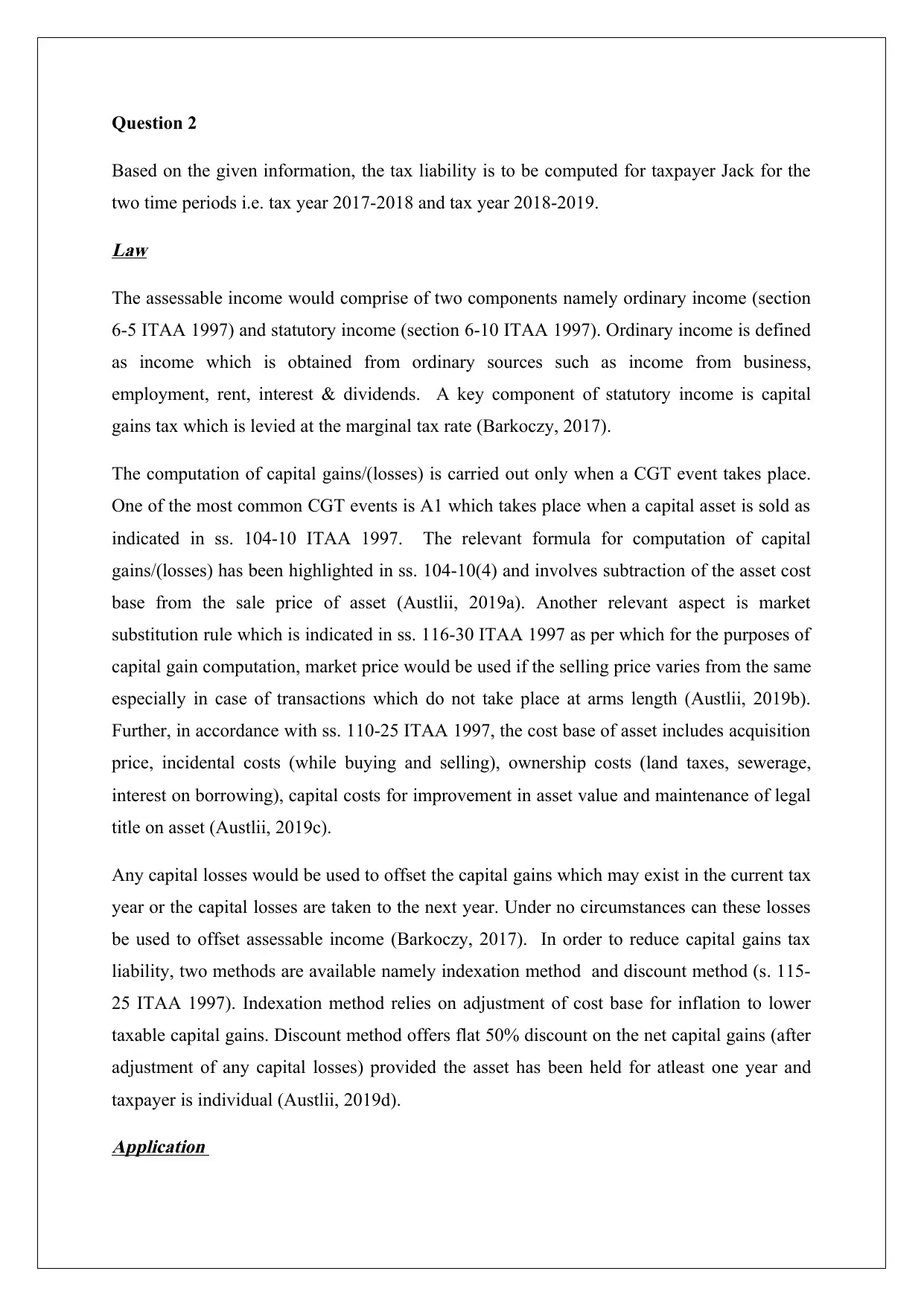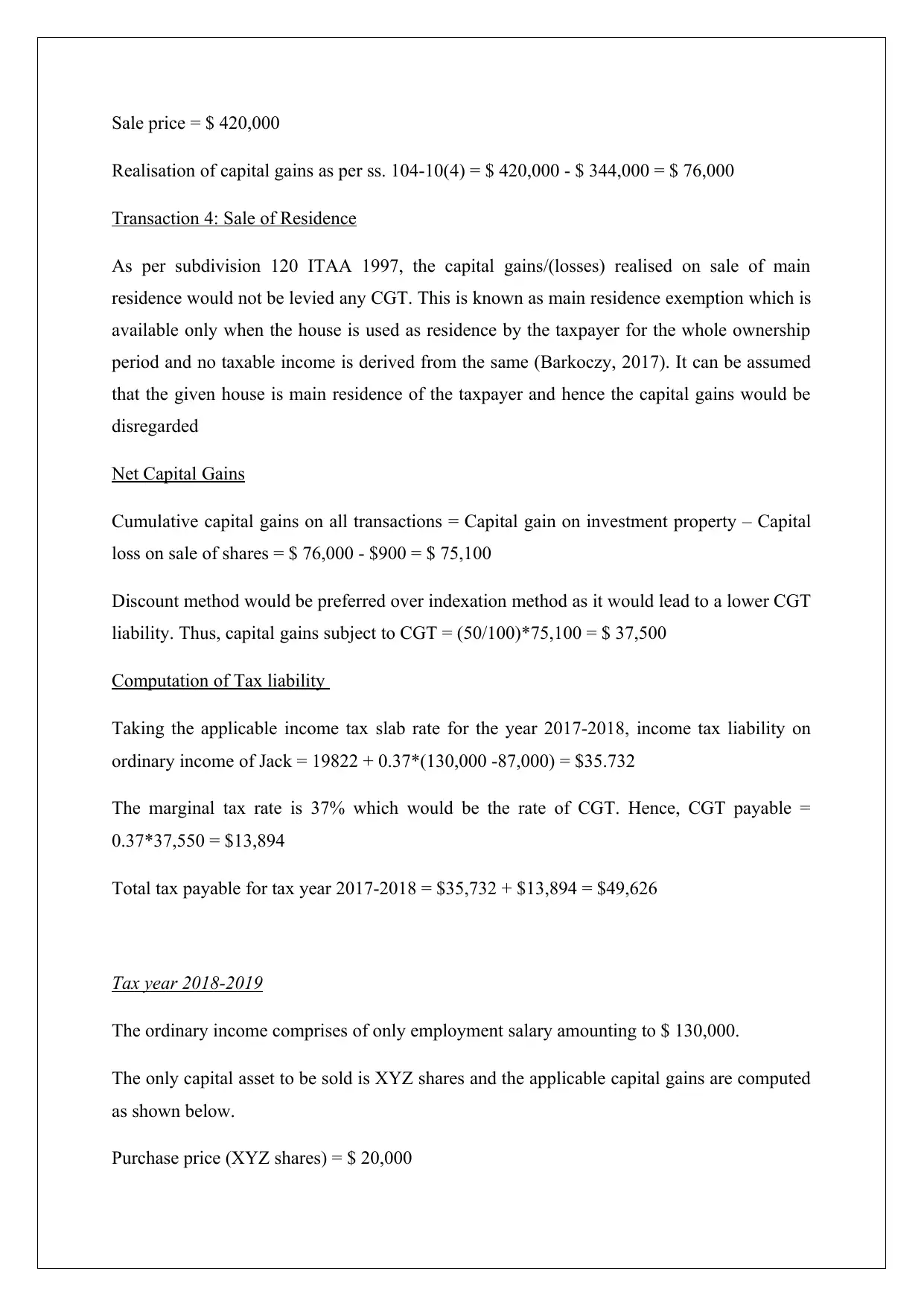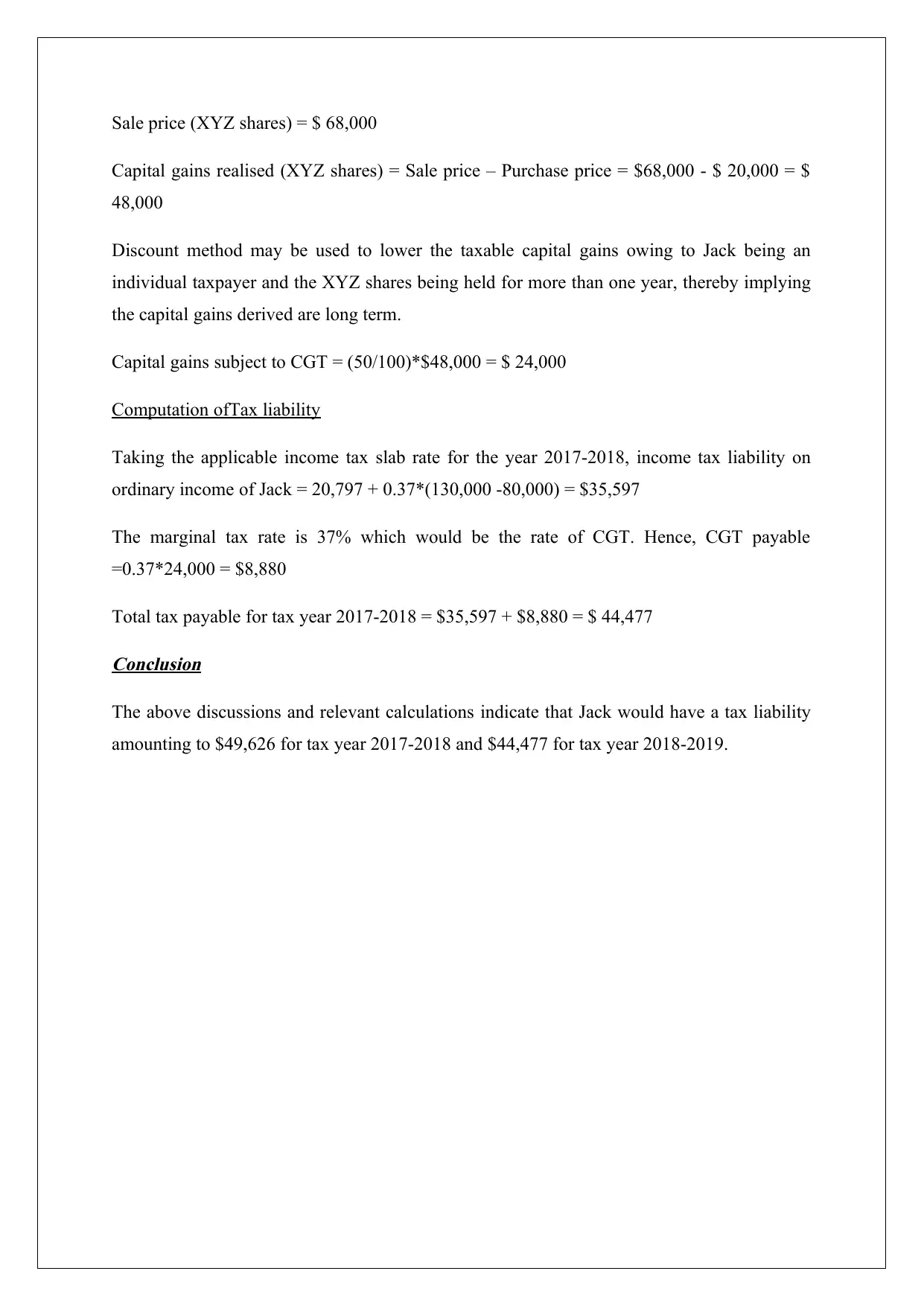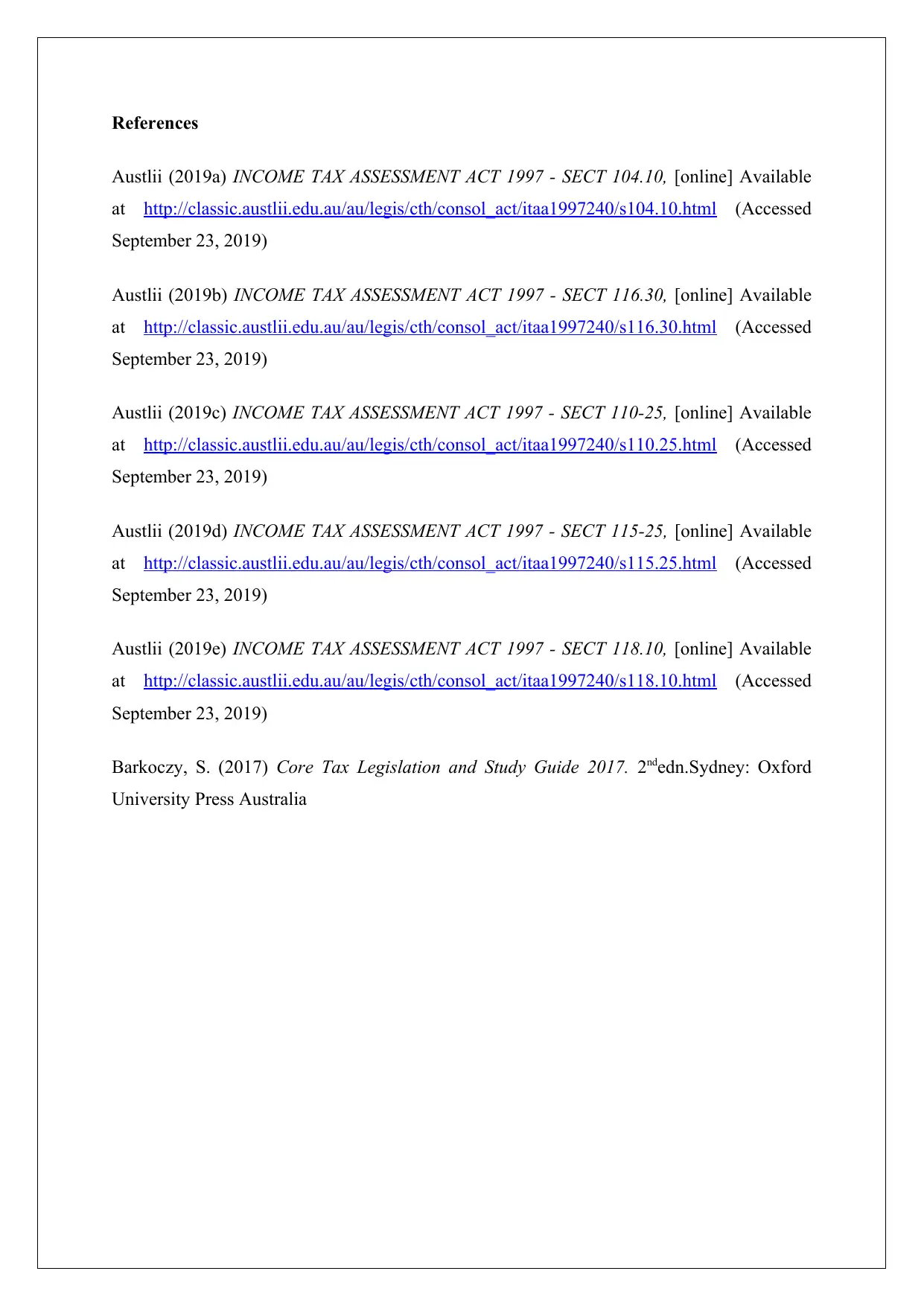Taxation Law Assignment: CGT Calculation for Jack's Tax Liability
VerifiedAdded on 2022/10/14
|6
|1421
|62
Homework Assignment
AI Summary
This assignment solution addresses a taxation law problem involving the calculation of Capital Gains Tax (CGT) and overall tax liability for a taxpayer named Jack across two tax years, 2017-2018 and 2018-2019. The solution begins by defining assessable income, encompassing both ordinary income (salary, rent) and statutory income (capital gains). It then outlines the CGT implications of various asset transactions, including the sale of shares in ABC Ltd and XYZ Ltd, an investment property, and a boat. The calculations consider the cost base, sale price, and market substitution rules where applicable. The solution also details the application of the discount method to reduce CGT liability. For the tax year 2017-2018, the solution calculates ordinary income, capital gains from the investment property, and capital losses from the sale of shares, leading to a net capital gain subject to CGT. The tax liability for this year is then computed, considering both ordinary income tax and CGT. For the tax year 2018-2019, the solution focuses on the capital gains from the sale of XYZ shares and computes the corresponding tax liability. The solution concludes with the total tax payable for each year and provides references to relevant legislation.

TAXATION LAW
STUDENT ID:
[Pick the date]
STUDENT ID:
[Pick the date]
Paraphrase This Document
Need a fresh take? Get an instant paraphrase of this document with our AI Paraphraser

Question 2
Based on the given information, the tax liability is to be computed for taxpayer Jack for the
two time periods i.e. tax year 2017-2018 and tax year 2018-2019.
Law
The assessable income would comprise of two components namely ordinary income (section
6-5 ITAA 1997) and statutory income (section 6-10 ITAA 1997). Ordinary income is defined
as income which is obtained from ordinary sources such as income from business,
employment, rent, interest & dividends. A key component of statutory income is capital
gains tax which is levied at the marginal tax rate (Barkoczy, 2017).
The computation of capital gains/(losses) is carried out only when a CGT event takes place.
One of the most common CGT events is A1 which takes place when a capital asset is sold as
indicated in ss. 104-10 ITAA 1997. The relevant formula for computation of capital
gains/(losses) has been highlighted in ss. 104-10(4) and involves subtraction of the asset cost
base from the sale price of asset (Austlii, 2019a). Another relevant aspect is market
substitution rule which is indicated in ss. 116-30 ITAA 1997 as per which for the purposes of
capital gain computation, market price would be used if the selling price varies from the same
especially in case of transactions which do not take place at arms length (Austlii, 2019b).
Further, in accordance with ss. 110-25 ITAA 1997, the cost base of asset includes acquisition
price, incidental costs (while buying and selling), ownership costs (land taxes, sewerage,
interest on borrowing), capital costs for improvement in asset value and maintenance of legal
title on asset (Austlii, 2019c).
Any capital losses would be used to offset the capital gains which may exist in the current tax
year or the capital losses are taken to the next year. Under no circumstances can these losses
be used to offset assessable income (Barkoczy, 2017). In order to reduce capital gains tax
liability, two methods are available namely indexation method and discount method (s. 115-
25 ITAA 1997). Indexation method relies on adjustment of cost base for inflation to lower
taxable capital gains. Discount method offers flat 50% discount on the net capital gains (after
adjustment of any capital losses) provided the asset has been held for atleast one year and
taxpayer is individual (Austlii, 2019d).
Application
Based on the given information, the tax liability is to be computed for taxpayer Jack for the
two time periods i.e. tax year 2017-2018 and tax year 2018-2019.
Law
The assessable income would comprise of two components namely ordinary income (section
6-5 ITAA 1997) and statutory income (section 6-10 ITAA 1997). Ordinary income is defined
as income which is obtained from ordinary sources such as income from business,
employment, rent, interest & dividends. A key component of statutory income is capital
gains tax which is levied at the marginal tax rate (Barkoczy, 2017).
The computation of capital gains/(losses) is carried out only when a CGT event takes place.
One of the most common CGT events is A1 which takes place when a capital asset is sold as
indicated in ss. 104-10 ITAA 1997. The relevant formula for computation of capital
gains/(losses) has been highlighted in ss. 104-10(4) and involves subtraction of the asset cost
base from the sale price of asset (Austlii, 2019a). Another relevant aspect is market
substitution rule which is indicated in ss. 116-30 ITAA 1997 as per which for the purposes of
capital gain computation, market price would be used if the selling price varies from the same
especially in case of transactions which do not take place at arms length (Austlii, 2019b).
Further, in accordance with ss. 110-25 ITAA 1997, the cost base of asset includes acquisition
price, incidental costs (while buying and selling), ownership costs (land taxes, sewerage,
interest on borrowing), capital costs for improvement in asset value and maintenance of legal
title on asset (Austlii, 2019c).
Any capital losses would be used to offset the capital gains which may exist in the current tax
year or the capital losses are taken to the next year. Under no circumstances can these losses
be used to offset assessable income (Barkoczy, 2017). In order to reduce capital gains tax
liability, two methods are available namely indexation method and discount method (s. 115-
25 ITAA 1997). Indexation method relies on adjustment of cost base for inflation to lower
taxable capital gains. Discount method offers flat 50% discount on the net capital gains (after
adjustment of any capital losses) provided the asset has been held for atleast one year and
taxpayer is individual (Austlii, 2019d).
Application

Tax year 2017-2018
Source of ordinary income include employment related salary along with rent from property.
Thus, ordinary income for taxpayer Jack = $ 120,000 + $10,000 = $ 130,000
The CGT implications would be computed based on the respective capital gains/(losses)
realised from the sale of following assets.
Transaction 1: Sale of ABC Ltd
Purchase price of shares (also the cost base since no additional holding or incidental costs) =
$ 1,400
Market price is different from selling price, but for capital gains computation, market price
will be used especially because the sale is to a friend.
Market value at time of sale = $500
Thus, capital loss on ABC Ltd disposal = 1400 – 500 = $900
Transaction 2: Sale of Boat
It is a personal use asset since Jack does not have any business related with boat. Any capital
losses which are derived from sale of personal use assets would be ignored and not used for
any offsetting as indicated in ss. 118-10 ITAA 1997 (Austlii, 2019e).
Cost base of boat = $ 12,000
Sale proceeds of boat = $ 9,000
As sale proceeds<cost base, hence capital losses are realised which are ignored.
Transaction 3: Sale of Investment property
Investment property acquisition price = $ 250,000
Legal costs for investment property sale = $ 2,000 (incidental costs while selling)
Land taxes, sewerage cost and depreciation (termed as ownership related costs) = $50,000 +
$12,000 + $30,000 = $92,000
Cost base as per ss. 110-25 = $ 250,000 + $92,000 + $ 2,000 = $ 344,000
Source of ordinary income include employment related salary along with rent from property.
Thus, ordinary income for taxpayer Jack = $ 120,000 + $10,000 = $ 130,000
The CGT implications would be computed based on the respective capital gains/(losses)
realised from the sale of following assets.
Transaction 1: Sale of ABC Ltd
Purchase price of shares (also the cost base since no additional holding or incidental costs) =
$ 1,400
Market price is different from selling price, but for capital gains computation, market price
will be used especially because the sale is to a friend.
Market value at time of sale = $500
Thus, capital loss on ABC Ltd disposal = 1400 – 500 = $900
Transaction 2: Sale of Boat
It is a personal use asset since Jack does not have any business related with boat. Any capital
losses which are derived from sale of personal use assets would be ignored and not used for
any offsetting as indicated in ss. 118-10 ITAA 1997 (Austlii, 2019e).
Cost base of boat = $ 12,000
Sale proceeds of boat = $ 9,000
As sale proceeds<cost base, hence capital losses are realised which are ignored.
Transaction 3: Sale of Investment property
Investment property acquisition price = $ 250,000
Legal costs for investment property sale = $ 2,000 (incidental costs while selling)
Land taxes, sewerage cost and depreciation (termed as ownership related costs) = $50,000 +
$12,000 + $30,000 = $92,000
Cost base as per ss. 110-25 = $ 250,000 + $92,000 + $ 2,000 = $ 344,000
⊘ This is a preview!⊘
Do you want full access?
Subscribe today to unlock all pages.

Trusted by 1+ million students worldwide

Sale price = $ 420,000
Realisation of capital gains as per ss. 104-10(4) = $ 420,000 - $ 344,000 = $ 76,000
Transaction 4: Sale of Residence
As per subdivision 120 ITAA 1997, the capital gains/(losses) realised on sale of main
residence would not be levied any CGT. This is known as main residence exemption which is
available only when the house is used as residence by the taxpayer for the whole ownership
period and no taxable income is derived from the same (Barkoczy, 2017). It can be assumed
that the given house is main residence of the taxpayer and hence the capital gains would be
disregarded
Net Capital Gains
Cumulative capital gains on all transactions = Capital gain on investment property – Capital
loss on sale of shares = $ 76,000 - $900 = $ 75,100
Discount method would be preferred over indexation method as it would lead to a lower CGT
liability. Thus, capital gains subject to CGT = (50/100)*75,100 = $ 37,500
Computation of Tax liability
Taking the applicable income tax slab rate for the year 2017-2018, income tax liability on
ordinary income of Jack = 19822 + 0.37*(130,000 -87,000) = $35.732
The marginal tax rate is 37% which would be the rate of CGT. Hence, CGT payable =
0.37*37,550 = $13,894
Total tax payable for tax year 2017-2018 = $35,732 + $13,894 = $49,626
Tax year 2018-2019
The ordinary income comprises of only employment salary amounting to $ 130,000.
The only capital asset to be sold is XYZ shares and the applicable capital gains are computed
as shown below.
Purchase price (XYZ shares) = $ 20,000
Realisation of capital gains as per ss. 104-10(4) = $ 420,000 - $ 344,000 = $ 76,000
Transaction 4: Sale of Residence
As per subdivision 120 ITAA 1997, the capital gains/(losses) realised on sale of main
residence would not be levied any CGT. This is known as main residence exemption which is
available only when the house is used as residence by the taxpayer for the whole ownership
period and no taxable income is derived from the same (Barkoczy, 2017). It can be assumed
that the given house is main residence of the taxpayer and hence the capital gains would be
disregarded
Net Capital Gains
Cumulative capital gains on all transactions = Capital gain on investment property – Capital
loss on sale of shares = $ 76,000 - $900 = $ 75,100
Discount method would be preferred over indexation method as it would lead to a lower CGT
liability. Thus, capital gains subject to CGT = (50/100)*75,100 = $ 37,500
Computation of Tax liability
Taking the applicable income tax slab rate for the year 2017-2018, income tax liability on
ordinary income of Jack = 19822 + 0.37*(130,000 -87,000) = $35.732
The marginal tax rate is 37% which would be the rate of CGT. Hence, CGT payable =
0.37*37,550 = $13,894
Total tax payable for tax year 2017-2018 = $35,732 + $13,894 = $49,626
Tax year 2018-2019
The ordinary income comprises of only employment salary amounting to $ 130,000.
The only capital asset to be sold is XYZ shares and the applicable capital gains are computed
as shown below.
Purchase price (XYZ shares) = $ 20,000
Paraphrase This Document
Need a fresh take? Get an instant paraphrase of this document with our AI Paraphraser

Sale price (XYZ shares) = $ 68,000
Capital gains realised (XYZ shares) = Sale price – Purchase price = $68,000 - $ 20,000 = $
48,000
Discount method may be used to lower the taxable capital gains owing to Jack being an
individual taxpayer and the XYZ shares being held for more than one year, thereby implying
the capital gains derived are long term.
Capital gains subject to CGT = (50/100)*$48,000 = $ 24,000
Computation ofTax liability
Taking the applicable income tax slab rate for the year 2017-2018, income tax liability on
ordinary income of Jack = 20,797 + 0.37*(130,000 -80,000) = $35,597
The marginal tax rate is 37% which would be the rate of CGT. Hence, CGT payable
=0.37*24,000 = $8,880
Total tax payable for tax year 2017-2018 = $35,597 + $8,880 = $ 44,477
Conclusion
The above discussions and relevant calculations indicate that Jack would have a tax liability
amounting to $49,626 for tax year 2017-2018 and $44,477 for tax year 2018-2019.
Capital gains realised (XYZ shares) = Sale price – Purchase price = $68,000 - $ 20,000 = $
48,000
Discount method may be used to lower the taxable capital gains owing to Jack being an
individual taxpayer and the XYZ shares being held for more than one year, thereby implying
the capital gains derived are long term.
Capital gains subject to CGT = (50/100)*$48,000 = $ 24,000
Computation ofTax liability
Taking the applicable income tax slab rate for the year 2017-2018, income tax liability on
ordinary income of Jack = 20,797 + 0.37*(130,000 -80,000) = $35,597
The marginal tax rate is 37% which would be the rate of CGT. Hence, CGT payable
=0.37*24,000 = $8,880
Total tax payable for tax year 2017-2018 = $35,597 + $8,880 = $ 44,477
Conclusion
The above discussions and relevant calculations indicate that Jack would have a tax liability
amounting to $49,626 for tax year 2017-2018 and $44,477 for tax year 2018-2019.

References
Austlii (2019a) INCOME TAX ASSESSMENT ACT 1997 - SECT 104.10, [online] Available
at http://classic.austlii.edu.au/au/legis/cth/consol_act/itaa1997240/s104.10.html (Accessed
September 23, 2019)
Austlii (2019b) INCOME TAX ASSESSMENT ACT 1997 - SECT 116.30, [online] Available
at http://classic.austlii.edu.au/au/legis/cth/consol_act/itaa1997240/s116.30.html (Accessed
September 23, 2019)
Austlii (2019c) INCOME TAX ASSESSMENT ACT 1997 - SECT 110-25, [online] Available
at http://classic.austlii.edu.au/au/legis/cth/consol_act/itaa1997240/s110.25.html (Accessed
September 23, 2019)
Austlii (2019d) INCOME TAX ASSESSMENT ACT 1997 - SECT 115-25, [online] Available
at http://classic.austlii.edu.au/au/legis/cth/consol_act/itaa1997240/s115.25.html (Accessed
September 23, 2019)
Austlii (2019e) INCOME TAX ASSESSMENT ACT 1997 - SECT 118.10, [online] Available
at http://classic.austlii.edu.au/au/legis/cth/consol_act/itaa1997240/s118.10.html (Accessed
September 23, 2019)
Barkoczy, S. (2017) Core Tax Legislation and Study Guide 2017. 2ndedn.Sydney: Oxford
University Press Australia
Austlii (2019a) INCOME TAX ASSESSMENT ACT 1997 - SECT 104.10, [online] Available
at http://classic.austlii.edu.au/au/legis/cth/consol_act/itaa1997240/s104.10.html (Accessed
September 23, 2019)
Austlii (2019b) INCOME TAX ASSESSMENT ACT 1997 - SECT 116.30, [online] Available
at http://classic.austlii.edu.au/au/legis/cth/consol_act/itaa1997240/s116.30.html (Accessed
September 23, 2019)
Austlii (2019c) INCOME TAX ASSESSMENT ACT 1997 - SECT 110-25, [online] Available
at http://classic.austlii.edu.au/au/legis/cth/consol_act/itaa1997240/s110.25.html (Accessed
September 23, 2019)
Austlii (2019d) INCOME TAX ASSESSMENT ACT 1997 - SECT 115-25, [online] Available
at http://classic.austlii.edu.au/au/legis/cth/consol_act/itaa1997240/s115.25.html (Accessed
September 23, 2019)
Austlii (2019e) INCOME TAX ASSESSMENT ACT 1997 - SECT 118.10, [online] Available
at http://classic.austlii.edu.au/au/legis/cth/consol_act/itaa1997240/s118.10.html (Accessed
September 23, 2019)
Barkoczy, S. (2017) Core Tax Legislation and Study Guide 2017. 2ndedn.Sydney: Oxford
University Press Australia
⊘ This is a preview!⊘
Do you want full access?
Subscribe today to unlock all pages.

Trusted by 1+ million students worldwide
1 out of 6
Related Documents
Your All-in-One AI-Powered Toolkit for Academic Success.
+13062052269
info@desklib.com
Available 24*7 on WhatsApp / Email
![[object Object]](/_next/static/media/star-bottom.7253800d.svg)
Unlock your academic potential
Copyright © 2020–2026 A2Z Services. All Rights Reserved. Developed and managed by ZUCOL.




